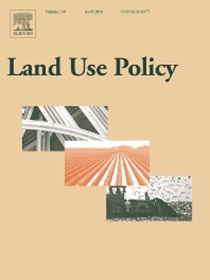Multiple cards in one place: Obstacles to achieving COP 15 goals
IF 5.9
1区 社会学
Q1 ENVIRONMENTAL STUDIES
引用次数: 0
Abstract
"Multiple Cards in One Place" pertains to the circumstance where multiple protected areas (PAs) are designated within the same geographical expanse, and natural resources are managed by multiple departments in an interlaced fashion, resulting in an inflated total PA area and impeding the achievement of the 30 × 30 target proposed at COP15. This phenomenon is referred to as “JiuLongZhiShui” in the domain of China's PA management. To address this issue, the initial step is to establish methodologies for assessing the influence of overlapping and interlaced settings on the conservation effectiveness, and subsequently propose adaptive strategies for diverse regions. In this study, the composite ecosystem service index (CESI) is used as a proxy for conservation effectiveness, and a combined method of basic grid-cell averaging and sample group comparison is proposed. Taking Qinghai province in China as an example, the study dissects the characteristics of alterations in the conservation effectiveness brought about by the overlapping protected areas (OPAs) at different scales, with the aim of determining the rationality of "Multiple Cards in One Place". The research outcomes indicate that the area of OPAs in Qinghai province constitutes 54.78 % of the total area of PAs in the province. The effectiveness of OPAs exhibits regional scale difference, ecological zone scale heterogeneity, and patch scale priority traits, and the optimal conservation layer varies for different spaces. The central-local departmental division mechanism, fund allocation and usage mechanism, local conservation and regional development mechanism collectively impact the effectiveness of OPAs. This study resolves the long-standing debate regarding whether "Multiple Cards in One Place" can enhance conservation effectiveness and assists policymakers in formulating targeted ecological optimization and regulation measures.
多张牌放在一个地方:实现COP 15目标的障碍
“一地多牌”是指在同一地理范围内划定多个保护区,自然资源由多个部门交叉管理,导致保护区总面积膨胀,阻碍了COP15提出的30 × 30目标的实现。这种现象在中国的PA管理领域被称为“九龙之水”。为了解决这一问题,首先要建立评估重叠和交错环境对保护效果影响的方法,然后提出不同区域的适应策略。本研究以综合生态系统服务指数(CESI)作为生态系统保护效果的指标,提出了基本格元平均和样本组比较相结合的方法。本研究以青海省为例,剖析不同尺度重叠保护区保护效果变化特征,以确定“一地多牌”的合理性。研究结果表明,青海省大气保护区面积占全省大气保护区总面积的54.78 %。OPAs的有效性表现出区域尺度差异、生态区尺度异质性和斑块尺度的优先性特征,最优保护层在不同空间存在差异。中央-地方部门划分机制、资金分配和使用机制、地方保护机制和区域发展机制共同影响OPAs的有效性。本研究解决了长期以来关于“多牌在一地”能否提高保护效果的争论,有助于决策者制定有针对性的生态优化和调控措施。
本文章由计算机程序翻译,如有差异,请以英文原文为准。
求助全文
约1分钟内获得全文
求助全文
来源期刊

Land Use Policy
ENVIRONMENTAL STUDIES-
CiteScore
13.70
自引率
8.50%
发文量
553
期刊介绍:
Land Use Policy is an international and interdisciplinary journal concerned with the social, economic, political, legal, physical and planning aspects of urban and rural land use.
Land Use Policy examines issues in geography, agriculture, forestry, irrigation, environmental conservation, housing, urban development and transport in both developed and developing countries through major refereed articles and shorter viewpoint pieces.
 求助内容:
求助内容: 应助结果提醒方式:
应助结果提醒方式:


